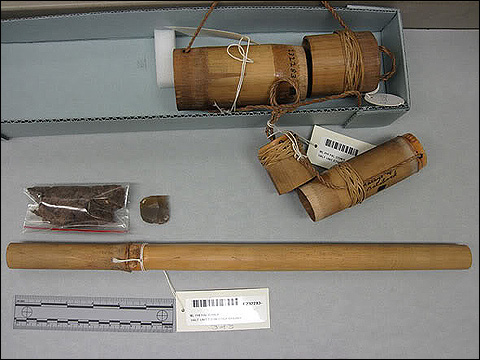
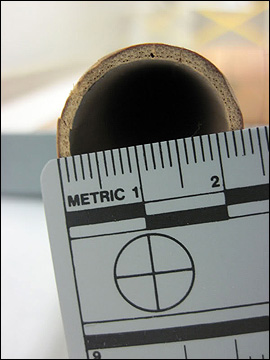
© E. Read 2011
Bamboo-Strike-A-Light
(excerpts from a thread on Bushcraft UK, a website community forum, and e-mail correspondences)
http://www.bushcraftusa.com/forum/showthread.php?t=4010&page=2
Ed Read
As far fetched as this technique seems, it really does work. One will have to hunt down the proper materials first. . . . . I've had success with chert, flint, and broken china as strikers. I like a dull edge, rough, but not sharp. I like to quickly rub the striker along the culm of bamboo, but the movie I have of a Papuan shows him using a striking motion as we do with flint and steel. For tinder, I have had success with thin charred cloth and the traditional 'lulut' made from Caryota palm tricomes (a.k.a. fluff, skirf, hair), and charcoal. With the Caryota and charcoal mix, I have only had real success by adding KNO3, salt peter. My research has finished finding the bamboo species used, and is now focused on traditional tinder and it's preparation. In Papua, it is reported that the tinder is made from bark. There may be many workable combinations.
Materials are the key. I don't know of anyone else who has done this recently other than my friend Tom [Lourens], who really earned his first fire. It took encouragement and an hour of determination. It can be discouraging if you don't have the correct combination. You need to experiment. Start by making sure you get good sparks. Sparks that fly off the culm and not just a streak of light where the striker rubbed or struck. You will smell the result of your work. Memories of the dentist will come to mind. If you are familiar with the tinder necessary for flint and marcasite, you know something about tinder quality. Use this knowledge. I get more sparks from proper bamboo than with marcasite, but I can't use my fluffed up tinder fungus because it falls apart on me when I strike. The same for the Caryota, but it gets stuck together with the addition of salt peter. . . . Ash [Kivilaakso] and Tom [Lourens] are two friends of mine whom I've been researching this technique. Tom is an excellent researcher and Ash is doing the real exploring, searching out people who know the techniques . . . .
I've studied the bamboo strike-a-lights figured in Walter Hough's book that are held at the Smithsonian. I've held them in my hands and looked at them very carefully. I've looked at the tinder and compared it to that with the numerous fire pistons. The bamboo looked exactly like the bamboo I use in one of the videos, the one where I am in the workshop. It's Schizostachyum lumampao as far as I can tell. Schizostachyum is a genus of tropical bamboo with species having long internodes, some reaching over a meter. They are used for making blowguns and numerous household articles. They require warm temperatures. I am searching for a usable bamboo that can grow year round in our southern California climate. The bamboo strike-a-light bamboo has a hard rough epidermis when mature and dry. I have tried using fresh cut bamboo with no success of obtaining sparks. I only got the burning smell. Bamboo can be relatively green while dead and standing. . . . You can experiment with bamboo in your area, that is found at stores, or any bamboo articles you may have. I noticed that my bamboo steamer is made out of a very similar bamboo as the strike-a-light. You will feel a degree of roughness as you run your finger over the epidermis.
Read Walter Hough's book Fire as an Agent in Human Culture, the best book on primitive fire making ever.
http://www.bushcraftuk.com/forum/showthread.php?t=51479&highlight=bamboo+strike-a-light
Ed Read
Bamboo Strike-a-Light Sets
I wanted to share with you all a couple of photos from my visit to the [Smithsonian] museum. I was fortunate to have a chance to inspect and photograph the fire pistons and bamboo strike-a-lights in their holdings. I also saw sets of fire thongs, hand drills and several beautiful Inuit strap drills, accessions Nelson brought back from Alaska. I could have easily spent a week there, but I was limited to 5 hours and had to stick to a pre-determined list of all the strike-a-lights and fire pistons.
All sets are illustrated in black and white in books by Walter Hough, but have not been photographed since. I wanted to see them in person to look for clues to determine the species of bamboo, formulation of tinder, types of strikers included, and general design.
Anthropologists learn the craft they study to better understand it. I have been lucky enough to successfully start fire using the bamboo strike-a-light method and in learning to do so came up with several questions.


© E. Read 2011
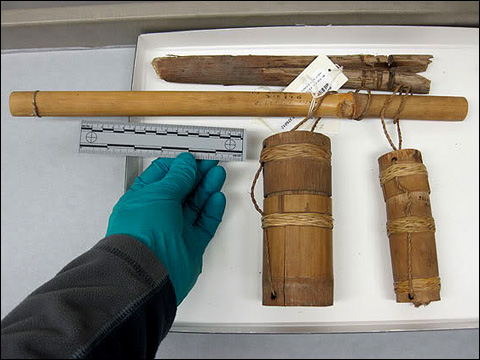
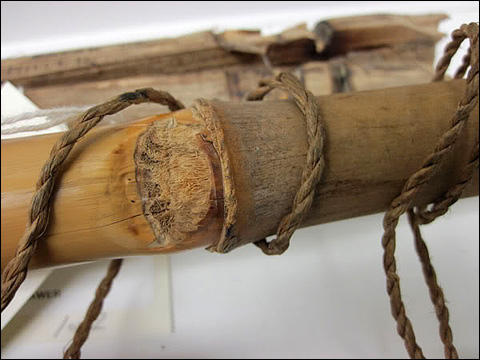
© E. Read 2011
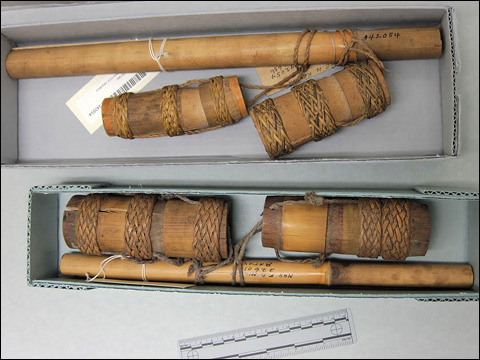
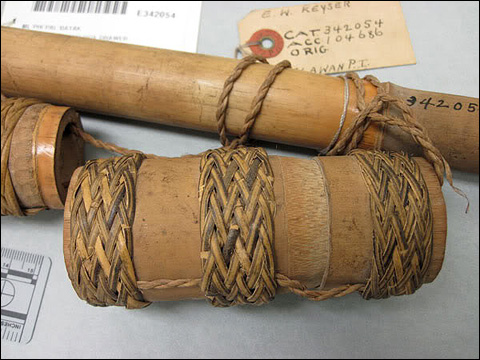
© E. Read 2011
Bamboo Strike-A-Light sets from the Philippines.
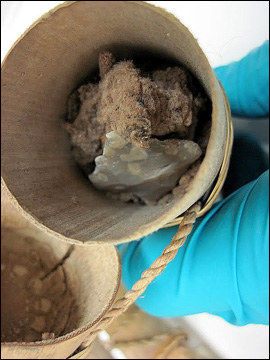
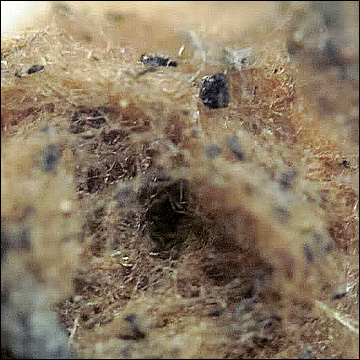
© E. Read 2011
Tinder/flint bamboo container and tinder.
All of the tinder included in the sets is of Caryota palm fibers mixed with charred/charcoal material. Strikers are of firearm flints, native rock, and porcelain with dull, not sharp, edges. All spark producing bamboo appeared to be the same type. All accessions observed are from the Philippines. Both short scrapes and long scrapes are present on the spark producing bamboo, mostly short.
As far as I can tell, the bamboo is identical to that which I got from my friend Ivan, which was imported from the Philippines. Without going into the whole story, I have been studying bamboo taxonomy for over a year (I am a botanist) and have read all the literature pertaining to the genus Schizostachyum. The taxonomy isn't clear cut and taxonomists state that several of the named species may be only one species. I go by the groups or complexes within the genus and my findings match that which Ash has found. He met with the best bamboo taxonomist in Malaysia and showed him examples of the strike-a-light bamboo he obtained. It is of the Schizostachyum jaculans group which contains S. jaculans, S. iraten, S. lima, S. lumampao and other poorly described species. The main characteristic used to identify the species is removed when making the fire-making set, the culm sheath. A clue to the name of the bamboo was given by Walter Hough in his book Fire as an Agent in Human Culture. He called the type of bamboo used "buyo", which is probably another spelling for what is today written "buho" or Schizostachyum lumampao. Believe me when I say that bamboo taxonomy is vague in this group of Schizostachyum. The descriptions can be very frustrating lacking illustrations and the not-until-recently discovered useful characteristics of the shoot, culm sheath, and floral anatomy. . . . .
Photos of bamboo strike-a-light kits from the collection of the the National Museum of Ethnology (Rijksmuseum voor Volkenkunde) in the city of Leiden in the Netherlands:
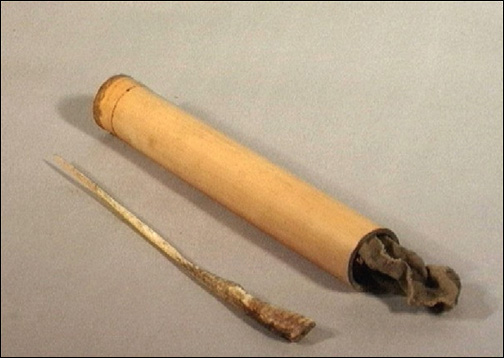
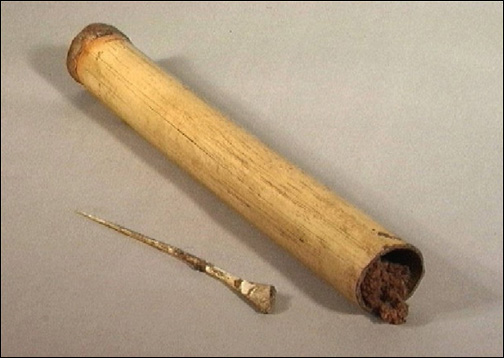
http://www.bushcraftuk.com/forum/showthread.php?t=10517&page=5
Ed Read
In Fire-making Apparatus in the United States National Museum by Hough, he wrote "The bamboo selected and from which the specimens in the United States National Museum are made has a rough surface layer feeling like fine sandpaper. This coating is in the form of a flinty layer about one-half millimeter thick, which is chipped away in small bits under the stroke of the china. The material of the layer is probably a combination of silica with some organic substance rendering it capable of taking up the force of the blow and converting it into heat sufficient to ignite tinder."
Hough earlier wrote in Fire as an Agent in Human Culture, "The writer finds no difficulty in making fire by this method." I have to assume that he was referring to himself because his references make no statements as to attempting it themselves. He followed with, "Observations on the specimens in the United States National Museum show that a particular kind of bamboo having a hispid siliceous coating is used. The Filipinos call this bamboo buyo." I have found a bamboo called buho or bulo, but not buyo which is their name for bettle nut stuff. This Filipino buho is Schizostachyum lumampao and it has long internodes and thin walled culms. Hough follows with a statement about the tinder, which someone at Kew identified as "scurf down of a species of Caryota palm". We know from other accounts that this palm is Caryota mitis.
On further note, I need to make a correction to an earlier statement regarding culms and silica content. I said that the base of a culm matures first. This is true. I then said that because it matures first and holds the weight and torque of the entire culm, it is the strongest. This is also probably true BUT, I made the assumption that this would also be the area of highest silica content and this is not true according to The Anatomy of Bamboo Culms by Walter Liese. You can read it using Google Book Search; page 88. I quote, "Silica is a major constituent of the epidermis with values between 1.5 % (Bambusa vulgaris) and 6.4% (Schizostachyum lumampao). It consists of small crystals of silicon dioxide and is mainly localized in the shorter epidermal cells. . . . . The silica content increases towards the upper culm parts." So, this is something else to think about when searching for strike-a-light culms.
http://www.bushcraftuk.com/forum/showthread.php?t=10517&page=5
Tom Lourens
In contrast to Walter Hough, the French Docteur Roussel reckons that the Philippinean species is Schizostachyum lima, not Schizostachyum lumampao.
Hough states the vernacular name as "buyo", a Tagalog name for Schizostachyum lumampao, a species that is restricted to the Philippines. Roussel proposes S. lima because of its wider distribution (Borneo, the Philippines, the Moluccan islands, New Guinea), which would account for the bamboo percussion method being used in these locations outside of the Phillippines. Although the Tagalog name of this species is "anos", it is called "buho" in another Philippinean language (panay bisaya), a close match with Hough's "buyo". Furthermore, Roussel states that the epitheton "lima" is derived from the Latin for limestone, most probably because of the rough surface of this species, which was used for polishing bronze.
http://www.bushcraftuk.com/forum/showthread.php?t=10517&page=5
Hoodoo
Silica is commonly incorporated into the tissues of plants as a defense against herbivores. Very common in grasses. This is also an "induced defense" meaning that an increase in grazing by an herbivore can cause an increase in silica uptake by the plant.
http://www.bushcraftuk.com/forum/showthread.php?t=10517&page=5
Ash Kivilaakso
You may recall that Jamit was selecting some and discarding other culms, while I merrily collected any I could see. Subsequently, I noticed that some sections had much better spark generation that others. Some 19th century sources also said that the correct, well seasoned wood was critical.
Have you heard of “tabashir” or ”tabasheer"? I came across it in some alternative medicine sites. It is an ingredient in Ayurvedic medicine. It is an opaline stone/deposits found on some bamboos, especially near the internodes. It is a response to stress. Apparently there is more in the female bamboo, especially Schizostachyum iraten. It is siliceous up to 75% with other components. It has been traded for hundreds of years, if not longer. This may be what he was looking for.
Information on silica in bamboo:
Bamboo extract is the richest known source of natural silica containing over 70% organic silica. This is more than 10 times the level as found in the widely used Horsetail plant (Equisetum) that contains about 5-7% silica. Silicon (Si) is the second most abundant element on earth after oxygen. It is a sister element of carbon.
The structural strength and hardness of bamboo stems is due to masses of heavily lignified tracheids and fibers associated with the vascular bundles. The wood (xylem) of conifers and dicot trees is composed of concentric layers of dense, lignified cells containing cellulose and lignin in their secondary walls. In addition to cellulose and lignin, the thick-walled fibers of bamboo also contain up to five percent silica in the form of silicon dioxide (SiO2). Although bamboo culms do not have the structure of true wood, they are very hard because they contain silica and lignin.
Bamboo is a grass and one consequence of this is that the silica content is much higher than for wood plants. The presence of silica is the way that the plant is protecting itself from the environment. Trees use bark for protection while annual plants have high silica content, which acts as a "skin" for the plant.
http://www.bushcraftuk.com/forum/showthread.php?t=10517&page=5
Ed Read
I’ve been learning a lot about bamboo and have found some good info to help find out what the species of bamboo is that you got on your bamboo fire quest. Tom already listed this info, but I'll repeat it: According to the plant names website: http://www.plantnames.unimelb.edu.au/Sorting/Frontpage.html
1. Schizostachyum jaculans = Buloh temiang
2. Schizostachyum blumei = Buluh tamiang
3. Schizostachyum irratun/en = Bambu tamiyang
It turns out that one of the important parts of the bamboo to use to identify it is the culm sheath from the middle of the stalk. . . . If you are at all interested in learning more about bamboo, I recommend an excellent website here: http://bamboo-identification.co.uk/index.html
It has detailed information on what is necessary to identify species and also gives links to detailed descriptions. I’ve come to the preliminary conclusion that a few of the Schizostachyum species will work to make fire and it isn’t just one species alone. Possibly both Schizostachyum jaculans and Schizostachyum blumei will work.
To answer your question as to what you will need to photograph or collect for identification:
• An entire plant showing how the stalks stand/bend with a reference to size (person) if possible. We need to see how the stalks stand and or droop.
• Photographs of the nodes or rings along the stalk showing the branches coming out along with any buds etc. Include a ruler for size reference. We need to see how many branches come out of each node and what the branches look like as far as branching and length.
• Close ups of culm sheaths from the middle section of the stalk. Remove one and lay it flat with a ruler next to it. Take pictures of the auricles and ligules - there are hairs and protrusions on these that are used to identify the species. I’m told that people can identify species using just a culm sheath! For a definition of what an auricle is, see: Morphology>Components . . . http://bamboo-identification.co.uk/html/leaves.html
• Measurements of the internodes. Lengths, cross section showing wall thickness (include ruler). Schizostachyum are thin walled bamboo.
• A branch with leaves and close ups of the leaves showing hairs, powder etc.
Also, if you can find out other uses for the same bamboo, it could quickly confirm our findings. I think both S. jaculans and S. blumei are used for making blowguns. One species has longer culms so they only need one internode while the other is shorter so they use two stuck together.
Unfortunately, Schizostachyum is rare in cultivation here in the United States. I only found one vendor in Florida.
Here is a description for Schizostachyum jaculans:
Perennial; caespitose.
Rhizomes short; pachymorph.
Culms 600–700 cm long; 20–35 mm diam.; woody.
Culm-internodes terete; thin-walled; 50–80 (–125) cm long; distally pruinose.
Lateral branches dendroid. Branch complement many.
Culm-sheaths 15–30 cm long; pubescent; with erect hairs; with tawny hairs; truncate at apex; auriculate; with 1 mm high auricles; setose on shoulders; shoulders with 8–12 mm long hairs.
Culm-sheath ligule 2 mm high; ciliate.
Culm-sheath blade linear; reflexed; 10–25 cm long; 7–18 mm wide.
Leaf-sheath oral hairs scanty; 5–10 mm long. Leaf-sheath auricles falcate.
Ligule an eciliate membrane.
Leaf-blade base with a brief petiole-like connection to sheath; petiole 0.3–0.7 cm long.
Leaf-blades lanceolate; 12–30 cm long; 12–50 mm wide.
Leaf-blade surface pubescent; hairy abaxially.
http://www.bushcraftuk.com/forum/showthread.php?t=10517&page=3&s=4d7cc6c8ec0e8e701c996becca1a9408
Tom Lourens
Schizostachyum blumei Nees (PROSEA,Wang)
SYNONYM(S) : Melocanna zollingeri Steudel var. longispiculata Kurz. ex Munro (PROSEA), Schizostachyum longispiculatum (Kurz ex Munro) Kurz (PROSEA)
CHINESE : Zhao wa si lao zhu.
ENGLISH : Borneo schizostachyum.
FRENCH : Schizostachyum de Borneo.
MALAY : Bongulungul (Sabah), Buloh anap (Sabah), Buluh lacau (Brunei, Indonesia), Buluh tamiang (Indonesia), Pring wuluh (Indonesia), Pring jawa, Tombotuon (Sabah).
SUNDANESE : Awi bunar (Indonesia), Awi tamiyang (Indonesia).
Schizostachyum iraten Steudel (PROSEA)
SYNONYM(S) : Schizostachyum biflorum McClure (PROSEA)
ENGLISH : Bali blowpipe bamboo, Bali schizostachyum, Java schizostachyum, Sumatra schizostachyum.
FRENCH : Schizostachyum de Bali, Schizostachyum de Java, Schizostachyum de Sumatra.
MALAY : Pring wuluh (Java).
SUNDANESE : Awi bunar (Indonesia), Awi tamiyang (Indonesia).
Schizostachyum irratun Kurz (OHRN)
MALAY : Bambu tamiyang (Indonesia).
Could this taxon (specific name) be a synonym of Schizostachyum iraten? D. Ohrnbereger says that it is of doubtful status.
Schizostachyum jaculans Holttum (PROSEA)
MALAY : Buloh kasap, Buloh sumpitan, Buloh temiang.
The name te-miang refers to the "miang", fine irritating fibres/hairs that often cover the nodes and culm that can cause acute irritation and rash.
Map of where the genus Schizostachyum are found in the world:
http://www.discoverlife.org/mp/20m?kind=Schizostachyum&guide=Invasive_plants_of_South_Africa
Photos of palm tinder by Ash Kivilaakso:
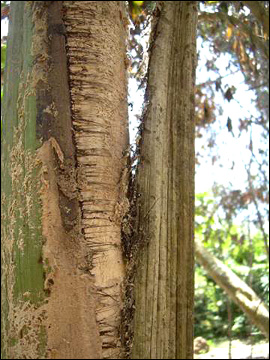
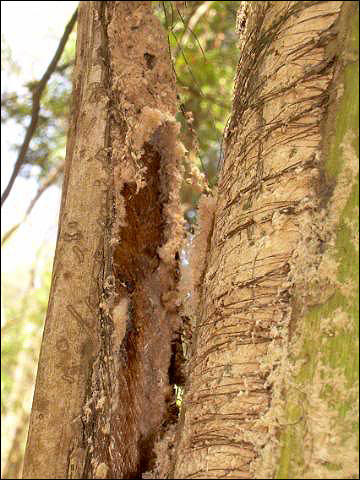
© A. Kivilaakso 2011
Caryota mitis tinder
http://www.bushcraftuk.com/forum/showthread.php?t=10517&page=4
Ed Read
. . . . Most of the literature that I have found lists palm tinder coming from the subfamily Caryotoideae (Fishtail Palms). Arenga pinnataand Caryota mitisbeing the most common. Chamaerops ritchiana is used in Pakistan, Elaeis melanococca is used in Brazil, Caryota urens is used in Lakhimpur (India) and so on.
. . . . Useful Palms of the World, a synoptic bibliography by Michael Balick, 1990. This amazing book lists numerous palms used for tinder. Most are in the subfamily Caryotoideae. . . . .
Fire-making Using a Stone 'Strike-A-Light' in the Soa Basin of Flores, Indonesia by Adam Brumm. . . . . This is a must read and see, especially for Ash. You are my second find for a reference for adding charred material to the palm fiber to prepare the tinder and it really works great! Oh, the people use charred coconut fiber for the additive to the palm fiber.
Palms of Malaya by T. C. Whitmore, 1977. . . . . on page 45 it reads: "The fluff which can be scraped off the leaves and sheaths are used for tinder. In Kelantan, gobek api is a remarkable means of making fire-by-friction and compression utilizing this tinder. . . . . " Yeah, I know you're dying to know what tukas is, well it's very common in offices and malls around here. Caryota mitis or rabok, tukas, clumping fishtail palm.
. . . . what these guys are essentially doing is making charred cloth. The palm fiber ignites great in a fire piston, but will fail to continue to burn . . . . If you char something and mix it with it [palm tinder], you get a superb tinder. It will hold up to much more abuse than charred cloth and I think this is a key for us trying to start fires with bamboo and flint, etc. Now, why didn't the old gents mention this in their literature? Well, they didn't mention a lot of things like gaskets etc. and they did get a lot right, so I'm just happy to see that there are still people who know how to make this stuff alive today. I'll have to see if I can find any more references to adding charred material to the tinders mention in the book by Micheal Balick.
. . . . simply use charred cloth and mix it up with whatever fluff you can scrap off of the palm trees near you and go at it. I've had success with what we call Queen Palm, Buriti Palm, and Clumping Fishtail Palm so far. No need to deface anything, just do a modest scraping without pulling any leaves off. Oh, it should be mentioned that I've only used powdered charred cloth as an admixture so far. . . . .
. . . . A friend from Vietnam once told me of a bamboo that is so hard on the outside that it sometimes sparks when you cut it with a machete; just another testimony of the facts under investigation.
http://www.bushcraftuk.com/forum/showthread.php?t=10517&page=4
Ash Kivilaakso
. . . . You are right. The char material is a giant pandanus. And I believe that he was making powdered char fibre, but somewhat over did it. The lulut was not fully dried, as I was pushing to get back to town.
Photo of a bamboo strike-a-light using a piece of pottery as the striker from the Sougb region of Papua:
http://www.papuaweb.org/gb/foto/kawai/05l.html
http://www.bushcraftuk.com/forum/showthread.php?t=10517&page=4
Ed Read
. . . . just in case some of the readers didn't know, many types of pottery have crushed flint in them.
Excerpt from "Culture of Stone, Sacred and Profane Uses of Stone among the Dani" by O. W. 'Bud' Hampton:
". . . . To start a fire, the striking stone is held in one hand with bits of palm fuzz, charcoal, and leaf tinder that ignite from friction on about the third or fourth strike of the stone striker against the bamboo tube. The internodal section of bamboo that is both a container and a striking surface must be brittle from dryness to function successfully as the striking surface. It is presumed that the silicon dioxide (SiO2) phytoliths within the bamboo play a role in creating a hard, brittle surface against which a stone striker can produce either a spark or heat induced friction to ignite the special tinder."
Video of Tom Lourens striking the temiang bamboo with flint to create sparks in the dark:
http://s162.photobucket.com/albums/t258/galemys/?action=view¤t=P1000938.mp4
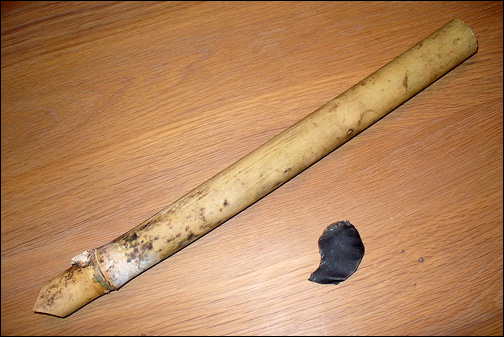
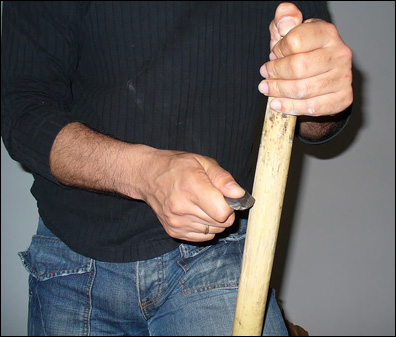
© T. Lourens 2011
Videos of Ed Read demonstrating the Bamboo Strike-A-Light:
http://www.youtube.com/watch?v=afu4SJxNMcY
E-mail your comments to "Ash Kivilaakso" in Malaysia at a.kivilaakso@gmail.com, "Tom Lourens" in the Netherlands at t.lourens@sanquin.nl, "Ed Read" in southern California at eread@exchange.fullerton.edu or "Dino Labiste" at KahikoArts@yahoo.com.
We hope the information on the PrimitiveWays website is both instructional and enjoyable. Understand that no warranty or guarantee is included. We expect adults to act responsibly and children to be supervised by a responsible adult. If you use the information on this site to create your own projects or if you try techniques described on PrimitiveWays, behave in accordance with applicable laws, and think about the sustainability of natural resources. Using tools or techniques described on PrimitiveWays can be dangerous with exposure to heavy, sharp or pointed objects, fire, stone tools and hazards present in outdoor settings. Without proper care and caution, or if done incorrectly, there is a risk of property damage, personal injury or even death. So, be advised: Anyone using any information provided on the PrimitiveWays website assumes responsibility for using proper care and caution to protect property, the life, health and safety of himself or herself and all others. He or she expressly assumes all risk of harm or damage to all persons or property proximately caused by the use of this information.
© PrimitiveWays 2017